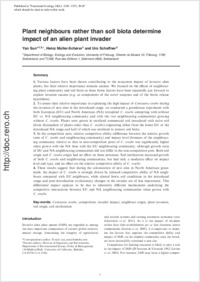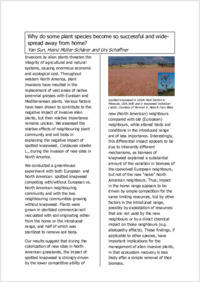Plant neighbours rather than soil biota determine impact of an alien plant invader
- Sun, Yan Department of Biology, Ecology and Evolution, University of Fribourg, Fribourg, Switzerland - CABI, Delémont, Switzerland - Division of Organisms and Environment, Department of Environmental Science, Policy & Management, University of California, Berkeley, USA
- Müller-Schärer, Heinz Department of Biology, Ecology and Evolution, University of Fribourg, Fribourg, Switzerland
- Schaffner, Urs CABI, Delémont, Switzerland
-
2014
Published in:
- Functional Ecology. - 2014, vol. 28, no. 6, p. 1545–1555
Centaurea stoebe
Competition
Invader impact
Neighbour origin
Plant invasion
Soil origin
Soil sterilization
English
1. Various factors have been shown contributing to the ecosystem impact of invasive alien plants, but their relative importance remains unclear. We focused on the effects of neighbouring plant community and soil biota as these biotic factors have been repeatedly put forward to explain invasion success (e.g. as components of the novel weapons and of the biotic release hypothesis).2. To assess their relative importance in explaining the high impact of Centaurea stoebe during the invasion of new sites in the introduced range, we conducted a greenhouse experiment with both European (EU) and North American (NA) tetraploid C. stoebe competing with/without EU vs. NA neighbouring community and with the two neighbouring communities growing without C. stoebe. Plants were grown in sterilized commercial soil inoculated with naïve soil (from rhizosphere of plants other than C. stoebe) originating either from the home EU or the introduced NA range and half of which was sterilized to remove soil biota.3. In the competition pots, relative competitive ability (difference between the relative growth rates of C. stoebe and neighbouring community) and impact level (biomass of the neighbouring community relative to that in non-competition pots) of C. stoebe was significantly higher when grown with the NA than with the EU neighbouring community, although growth rates of EU and NA neighbouring communities did not differ in the non-competition pots. Both soil origin and C. stoebe origin had no effect on these processes. Soil sterilization increased growth of both C. stoebe and neighbouring communities, but had only a moderate effect on impact level and type, and no effect on the relative competitive ability of C. stoebe.4. These results suggest that during the colonization of new sites in North American grasslands, the impact of C. stoebe is strongly driven by reduced competitive ability of NA neighbours compared with EU neighbours, while altered biotic soil conditions in the introduced range and post-introduction evolutionary changes in the invader are of less importance. This differential impact appears to be due to inherently different mechanisms underlying the competitive interactions between EU and NA neighbouring communities when grown with C. stoebe.
- Faculty
- Faculté des sciences et de médecine
- Department
- Département de Biologie
- Language
-
- English
- Classification
- Biological sciences
- License
-
License undefined
- Identifiers
-
- RERO DOC 234197
- DOI 10.1111/1365-2435.12295
- Persistent URL
- https://folia.unifr.ch/unifr/documents/304051
Other files
Statistics
Document views: 89
File downloads:
- pdf: 144
- Supplementary material: 177

